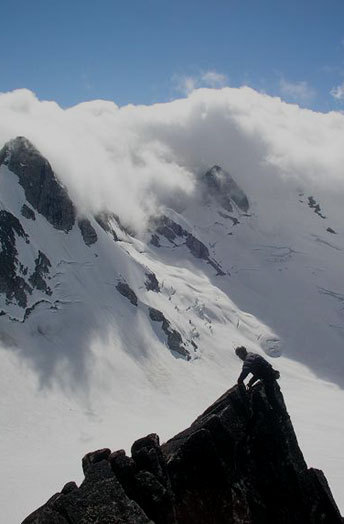
Blake Herrington on the first pitch of Gunrunner (IV 5.10 A1, 18 pitches, ca. 1,500? of gain and .75 miles long), Glacier Peak Wilderness Area, Cascades, Washington. On July 9, Herrington and Dan Hilden made the route’s first ascent, traversing across the four Gunsight peaks. Only a handful of the pitches had ever been climbed before, as the area is one of the most remote in the lower-48. Of this first pitch, a 5.10 fist-crack just off the Chickamin glacier, Herrington said: “We had gotten to the northern end of the ridgeline, saw the perfect splitter, and couldn’t resist.”
[Photo] Dan Hilden
In early July, Dan Hilden and I, both from Washington State, made the short trek to one of the most remote spots in the lower-48–the southern end of the Ptarmigan Traverse in Central Washington–to attempt the unclimbed four-peak Gunsight traverse. The peaks are located in the Glacier Peak Wilderness Area near the southern boundary of North Cascades National Park. Despite their difficult-to-reach location, the granite has been called (by Fred Beckey) some of the best in the Cascades.
Getting into the area is an enormous undertaking from any direction, but we chose the “easy” approach that took only two days from the east. Getting to the Gunsights required a fifty-mile boat ride up Lake Chelan, a ten-mile shuttle bus ride, ten miles of hiking by trail and 5,000 feet of vertical, off-trail bushwhacking and glacier travel. Due to high winds this past winter, more than 600 large trees had fallen across the trail, and wilderness restrictions in the area preclude the use of power tools for trail clearing. Consequently Dan and I became expert log climbers on the approach to our camp on the east side of the peaks, just below the Blue glacier.
On the morning of July 9, we circled along the west side of the Gunsight Peaks along the Chickamin glacier to the northern terminus of the ridge. Beginning with a pitch of steep, splitter granite hand cracks, we gained the ridge crest and began climbing north. We completed the traverse of all four named summits: Northeast, North, Middle and South Gunsight (all between 8,000 and 8,200′) by climbing the obvious line. We ascended the north faces on solid rock with good protection and rappelled the south sides.
We encountered three pitches of 5.10 crack climbing; we used one point of aid to pendulum out of a dead-end fist crack near the summit of the North Peak. The lack of a headlamp forced us to do the final pitch on the South peak and the descent, which included a free-hanging rappel over a moat onto the Blue glacier, in almost total darkness.

Blake Herrington atop the summit of North Gunsight, with Sinister Peak (left) and Dome Peak (right) in the background. [Photo] Dan Hilden
It is exciting that our route, Gunrunner (IV 5.10 A1, 18 pitches, ca. 1,500′ of gain and .75 miles long), had never been climbed despite the quality of rock and amazing location. Then again, only a handful of climbers are willing to carry heavy gear into such a remote destination. Of the eighteen pitches on Gunrunner, it is possible that only three (in the notch between North Gunsight and Middle Gunsight) had been climbed previously.
We made two other ascents during our trip: a new route, Accidental Discharge (II 5.10, 3 pitches), on the east face of South Gunsight on July 8, and the second ascent of Middle Gunsight’s east face (III 5.10d, 7 pitches) on July 10. Avoid Accidental Discharge unless you are looking for a broken, scary offwidth/chimney/dike.
Dan Hilden and myself have a combined age of just forty-one, less than half as old as Fred Beckey, whose 1940 first ascent signature still resides in the tiny register atop North Gunsight.